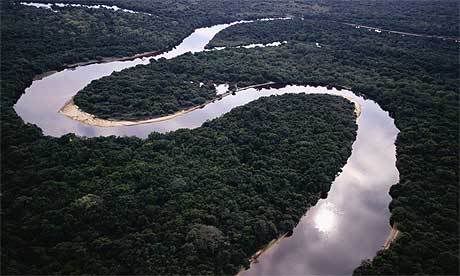
The Guardian reports:
Climate change could speed up the large-scale destruction of the Amazon rainforest and bring the "point of no return" much closer than previously thought, conservationists warned today.
Almost 60% of the region's forests could be wiped out or severely damaged by 2030, as a result of climate change and deforestation, according to a report published today by WWF.
The damage could release somewhere between 55.5bn-96.9bn tons of carbon dioxide into the atmosphere from the Amazon's forests and speed up global warming, according to the report, Amazon's Vicious Cycles: Drought and Fire.June 1989, Brazil: The forest burns. The Amazon is the largest rainforest in the world and is home to 15% of the world’s known land-based plant species, and nearly 10% of the world’s mammals. It has as many as 300 species of tree in a single hectare. Photograph: Sipa Press/Rex Features
Trends in agriculture and livestock expansion, fire, drought and logging could severely damage 55% of the Amazon rainforest by 2030, the report says. And, in turn, climate change could speed up the process of destruction by reducing rainfall by as much as 10% by 2030, damaging an extra 4% of the forests during that time.
By the end of the century, global warming is likely to reduce rainfall by 20% in eastern Amazonia, pushing up temperatures by more than 2C and causing forest fires, the report said.September 1988, Rondonia State, Brazil: Newly cleared land. Soya farming is one of the primary drivers of deforestation in the Amazon.
Photograph: Stephen Ferry/Liaison/Getty Images
Destroying almost 60% of tropical rainforest by 2030 would do away with one of the key stabilisers of the global climate system, it warned.
Such damage could have a knock-on effect on rainfall in places such as central America and India, and would also destroy livelihoods for indigenous people and some 80% of habitats for animal species in the region.
The "point of no return", in which extensive degradation of the rainforest occurs and conservation prospects are greatly reduced, is just 15-25 years away - much sooner than some models suggest, the report warns.
Releasing the report at the UN conference in Bali, which aims to begin negotiations on a new international climate change deal, the WWF called for a strategy to reduce emissions from forests and stop deforestation.
Beatrix Richards, the head of forests at WWF-UK, said: "The Amazon is on a knife-edge due to the dual threats of deforestation and climate change.
"Developed countries have a key role to play in throwing a lifeline to forest around the world. At the international negotiations currently underway in Bali governments must agree a process which results in ambitious global emission reduction targets beyond the current phase of Kyoto which ends in 2012.
"Crucially this must include a strategy to reduce emissions from forests and help break the cycle of deforestation."
The report's author, Dan Nepstead, senior scientist at the Woods Hole research centre in Massachusetts, said: "The importance of the Amazon forest for the globe's climate cannot be underplayed.
"It's not only essential for cooling the world's temperature but such a large source of freshwater that it may be enough to influence some of the great ocean currents, and on top of that it's a massive store of carbon."September 1988, Rondonia State, Brazil: The rainforest burns as a result of fires started by farmers and ranchers Photograph: Stephen Ferry/Liaison/Getty Images
June 1989, Brazil: Housing owned by a mining company which has been built on rainforest land Photograph: Sipa Press/Rex Features
November 2003, Para State, Brazil: After the loggers have harvested the trees, huge areas are burnt by cattle ranchers and soya producers who move onto the deforested land. Picture shows deforestation near Porto de Moz, where 80% of all timber produced is illegal Photograph: Tom Stoddart/Getty Images
November 2003, Para State, Brazil: Deforestation near Porto de Moz, where 80% of all timber produced is illegal Photograph: Tom Stoddart/Getty Images
April 2004, Rondonia State, Brazil: Smouldering pastureland cleared for cattle Photograph: Michael Nichols/National Geographic/Getty Images
September 2004, Novo Progreso, Brazil: An aerial view of deforestation caused by soybean farmers Photograph: Alberto Cesar/Greenpeace/AP
December 2004, Coari, Brazil: The Urucu oilfield, of state-owned Petrobras compan. Petrobras announced in 2004, that it will begin the construction of a 383 km long oil pipeline between the cities of Coari and Manaus. It took nearly two years, mainly for the opposition of environmental grups, to obtain the planning permission for the construcion of the stretch that will allow the oil to be taken from Urucu to Manaus, and that will require the deforestation of a 50m-wide strip along the way Photograph: Evaristo Sa/AFP/Getty Images
February 2005, Amapu, Brazil: An aerial picture of piles of wood at a sawmill Photograph: Antonio Scorza/AFP



No comments:
Post a Comment